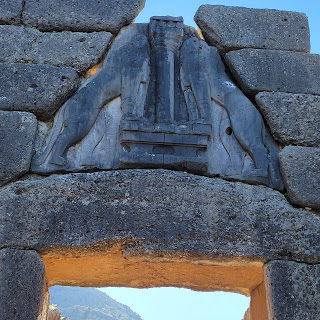We sailed from Crete to Nafplio overnight and anchored in the bay by daybreak.
Then we reported to the Star Theater to wait for our tender.
Palamidi fortress built by the Venetians in the second occupation 1686-1715 AD. They say it takes 999 steps to get to the top.
Our guide, Helen, was very emotionally invested in feeding the cats and dogs who live at the archeological site.
Our guide stated "Mykines" is the Greek version of Mycenae. She said the word has its origin in the same root as having to do with mushrooms. She stated there is some speculation about the use of hallucinogens in ancient rituals.
A model of the complex at this Archeological site, a UNESCO World Heritage Site. The ruins date to the Late Bronze Age, 1350 - 1200 BC.
There were many clay figures and pots on display. Many were replicas. Even though they were found here, the originals are kept at the Archeological Museum in Athens.
This bronze sword is very long. Too long for an average person to carry and wield in battle. Helen talked to us about the discovery of giant skeletons in Greece and the suppression of the information. 🤔
She noted the hilt of the sword is a mushroom shape.
This incomplete fresco is shown filled out by the research of archeologists in the pictures below. Pretty amazing how they can fill in the blanks.
The masonry walls are huge boulders. It is called Cyclopean Masonry because the classical Greeks believed only the Cyclopes had the strength to lift the stones and put them in place.
This is the walkway entering this large beehive tomb.
This is a huge, conical structure with curved walls. The black is caused by fires as shepherds used the structure before it was discovered by archeologists. The hole at the top has been covered on purpose
There are many such tombs in the area, but this is the largest and grandest.




























































No comments:
Post a Comment